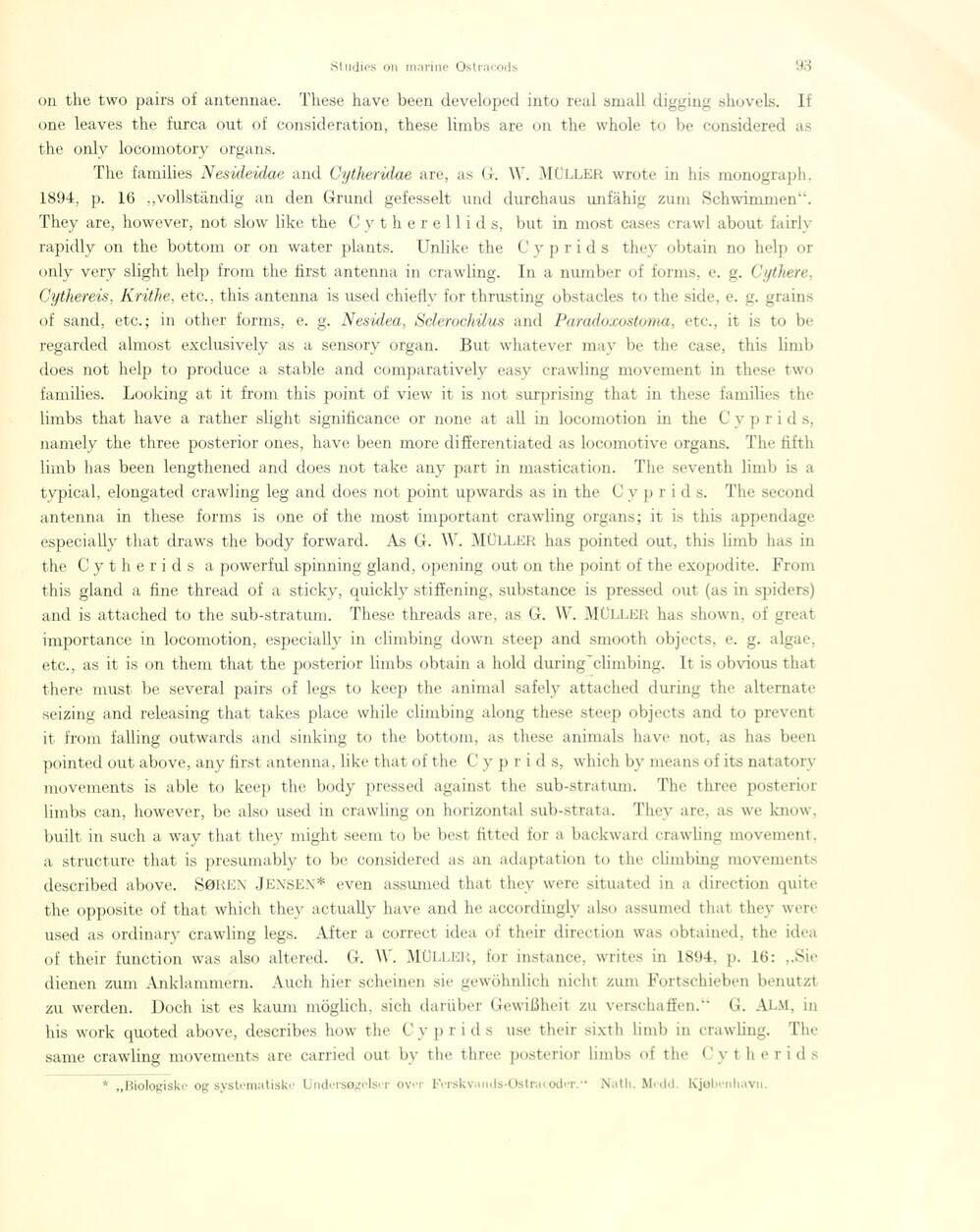
Full resolution (JPEG) - On this page / på denna sida - Sidor ...

<< prev. page << föreg. sida << >> nästa sida >> next page >>
Below is the raw OCR text
from the above scanned image.
Do you see an error? Proofread the page now!
Här nedan syns maskintolkade texten från faksimilbilden ovan.
Ser du något fel? Korrekturläs sidan nu!
This page has never been proofread. / Denna sida har aldrig korrekturlästs.
on the two pairs of antennae. These have been developed into real small digging shovels. If
one leaves the furca out of considération, these limbs are on the whole to be considered as
the only locomotory organs.
The families Nesideidae and Cytheridae are, as G. W. Müller wrote in his monograph.
1894, p. 16 „vollständig an den Grund gefesselt und durchaus unfähig zum Schwimmen“.
They are, however, not slow like the Cytherellids, but in most cases crawl about fa irly
rapidly on the bottom or on water plants. Unlike the C y p r i d s they obtain no help or
only very slight help from the first antenna in crawling. In a number of forms, e. g. Cythere,
Cythereis, Krithe, etc., this antenna is used chiefly for thrusting obstacles to the side, e. g. grains
of sand, etc.; in other forms, e. g. Nesidea, Sclerochilus and Paradoxostoma, etc., it is to be
regarded almost exclusively as a sensory organ. But whatever may be the case, this limb
does not help to produce a stable and comparatively easy crawling movement in these two
families. Looking at it from this point of view it is not surprising that in these families the
limbs that have a rather slight significance or none at all in locomotion in the C y p r i d s,
namely the three posterior ones, have been more difierentiated as locomotive organs. The fifth
limb has been lengthened and does not take any part in mastication. The seventh limb is a
typical, elongated crawling leg and does not point upwards as in the C y p r i d s. The second
antenna in these forms is one of the most important crawling organs; it is this appendage
especially that draws the body forward. As G. W. MÜLLER has pointed out, this limb has in
the Cytherids a powerful spinning gland, opening out on the point of the exopodite. From
this gland a fine thread of a sticky, quickly stifïening, substance is pressed out (as in spiders)
and is attached to the sub-stratum. These threads are, as G. W. MÜLLER has shown, of great
importance in locomotion, especially in climbing down steep and smooth objects, e. g. algae,
etc., as it is on them that the posterior limbs obtain a hold during’climbing. It is obvious that
there must be several pairs of legs to keep the animal safely attached during the alternate
seizing and releasing that takes place while climbing along these steep objects and to prevent
it from falling outwards and sinking to the bottom, as these animais have. not, as has been
pointed out above, any first antenna, like that of the C y p r i d s, which by means of its natatory
movements is able to keep the body pressed against the sub-stratum. The three posterior
limbs can, however, be also used in crawling on horizontal sub-strata. They are, as we know,
built in such a way that they might seem to be best fitted for a backward crawling movement,
a structure that is presumably to be considered as an adaptation to the climbing movements
described above. SØREN JENSEN* even assumed that they were situated in a direction quite
the opposite of that which they actually have and he accordingly also assumed that they were
used as ordinary crawling legs. After a correct idea of their direction was obtained, the idea
of their functi on was also altered. G. W. MÜLLER, for instance, writes in 1894, p. 16: „Sie
dienen zum Anklammern. Auch hier scheinen sie gewöhnlich nicht zum Fortschieben benutzt
zu werden. Doch ist es kaum möglich, sich darüber Gewißheit zu verschaffen.“ G. Alm, in
his work quoted above, describes how the C y p rids use their sixth limb in crawling. The
same crawling movements are carried out by the three posterior limbs of the C y t heri d s
* „Biologiske og systematiske Undersøgelser over Fersk va mls-Os tneoder." Natli. Medd. Kjøbenhavn.
<< prev. page << föreg. sida << >> nästa sida >> next page >>